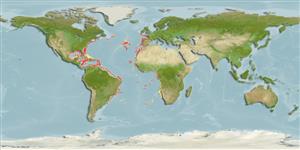>
Scombriformes (Mackerels) >
Trichiuridae (Cutlassfishes) > Aphanopodinae
Etymology: Aphanopus: Greek, aphanes = hidden + Greek, pous = foot (Ref. 45335).
Environment: milieu / climate zone / depth range / distribution range
Ökologie
seewasser benthopelagisch; tiefenbereich 300 - 1408 m (Ref. 6181). Deep-water; 50°N - 35°S, 105°E - 14°E (Ref. 6181)
Atlantic Ocean: in moderately warm and tropical waters; it has not been found only off the coast of South America. In the eastern Atlantic, it is found off western Sahara, Congo and Angola, from Sierra Leone submarine rise and Pilberry Seamount (Ref. 10818).
Size / Gewicht / Alter
Maturity: Lm ? range ? - ? cm
Max length : 148 cm TL Männchen/unbestimmt; (Ref. 108735)
Kurzbeschreibung
Morphologie | Morphometrie
Rückenflossenstacheln (insgesamt): 39 - 44; Rückenflossenweichstrahlen (insgesamt): 54-59; Afterflossenstacheln 2; Afterflossenweichstrahlen: 46 - 50; Wirbelzahl: 102 - 108. Pelvic fins represented by a single spine in juveniles inserted before the base of the pectoral fins but entirely absent in adults. Body is coppery black with iridescent tint. The inside of the mouth and gill cavities black.
Adults benthopelagic from 800 to 1,350 m, juveniles mesopelagic from 300 to 500 m (Ref. 6181). Up until recently, fisheries catch landings of A. carbo, a sympatric species in the waters of Canary and Madeira islands, were mixed with A. intemedius.
Life cycle and mating behavior
Geschlechtsreife | Fortpflanzung | Ablaichen | Eier | Fecundity | Larven
Displays determinate fecundity (Ref. 108695). Mature individuals undertake horizontal migration to spawning and nursery grounds (Ref. 108708).
Nakamura, I. and N.V. Parin, 1993. FAO Species Catalogue. Vol. 15. Snake mackerels and cutlassfishes of the world (families Gempylidae and Trichiuridae). An annotated and illustrated catalogue of the snake mackerels, snoeks, escolars, gemfishes, sackfishes, domine, oilfish, cutlassfishes,. scabbardfishes, hairtails, and frostfishes known to date. FAO Fish. Synop. 125(15):136 p. (Ref. 6181)
IUCN Rote Liste Status (Ref. 130435)
Bedrohung für Menschen
Harmless
Nutzung durch Menschen
Fischereien: kommerziell
Mehr Information
ReferenzenAquakulturAquakultur ProfilZuchtlinienGenetikElectrophoresesVererbbarkeitKrankheitenVerarbeitungNutrientsMass conversion
PartnerBilderStamps, Coins Misc.LauteCiguateraGeschwindigkeitSchwimmstilKiemenoberflächeOtolithsGehirngrößeSehfähigkeit
Tools
Zusatzinformationen
Download XML
Internet Quellen
Estimates based on models
Preferred temperature (Ref.
123201): 6.2 - 13.7, mean 9.4 °C (based on 190 cells).
Phylogenetic diversity index (Ref.
82804): PD
50 = 0.5078 [Uniqueness, from 0.5 = low to 2.0 = high].
Bayesian length-weight: a=0.00110 (0.00059 - 0.00203), b=3.09 (2.92 - 3.26), in cm total length, based on LWR estimates for this species & (Sub)family-body (Ref.
93245).
Trophic level (Ref.
69278): 4.3 ±0.7 se; based on size and trophs of closest relatives
Widerstandsfähigkeit (Ref.
120179): niedrig, Verdopplung der Population dauert 4,5 - 14 Jahre. (K=0.121; tmax=15).
Fishing Vulnerability (Ref.
59153): High vulnerability (62 of 100).
Climate Vulnerability (Ref.
125649): Moderate vulnerability (42 of 100).
Nutrients (Ref.
124155): Calcium = 7.2 [3.4, 23.3] mg/100g; Iron = 0.204 [0.058, 0.575] mg/100g; Protein = 15.8 [14.1, 17.6] %; Omega3 = 0.277 [0.112, 0.714] g/100g; Selenium = 42.9 [11.2, 142.5] μg/100g; VitaminA = 11.3 [2.0, 59.4] μg/100g; Zinc = 0.373 [0.178, 0.733] mg/100g (wet weight);
